
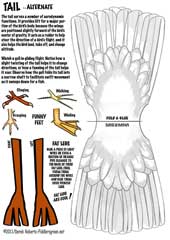
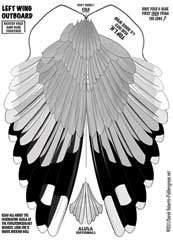
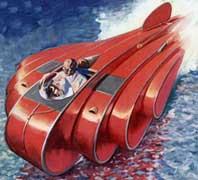
Herring-Gull-Glider - $$9.95
Offered in black and white (like the gull really is :), and in two sizes. There's also a goofy gull version that will smile away your recession blues. Its part of the Fiddlers Green Glider and Sailplane and Weird Aircraft Collection. There's a very unique Sea Gull Flying Boat model. Look for it in the Aircraft or Weird Aircraft Collection.
The Herring SEA GULL GLIDER
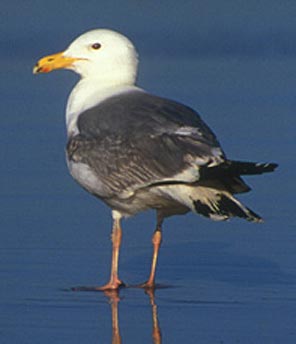 |
The Herring Gull is best known as a scavenger. It is most often seen in large, noisy flocks congregating where food is available, around fishing boats, picnic grounds and garbage dumps. Many people consider it a nuisance, but the Herring Gull performs a valuable service. It scavenges up great numbers of dead or injured animals
and organic litter which could pose a health threat to humans.
In the fields it devours large amounts of little tasty critters.
However, its natural diet includes aquatic life - fish, crustaceans
and, sometimes, the eggs and young of other species. The call
of the gull is distinctive; a shrill, screechy "Eurl"
repeated incessantly. Click to hear |
What people say:
Got me with the Herring Gull Glider :))...Ron Sheaffer 2/10
Herring gull aka: Larus argentatus aka: Seagull
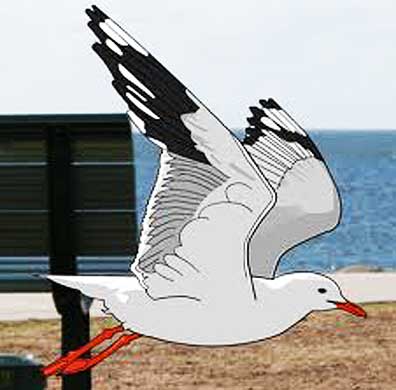 Although generally thought of as marine creatures, gulls are really
creatures of shorelines. Omnivorous, opportunistic scavengers,
the proliferation of open garbage dumps has
Although generally thought of as marine creatures, gulls are really
creatures of shorelines. Omnivorous, opportunistic scavengers,
the proliferation of open garbage dumps has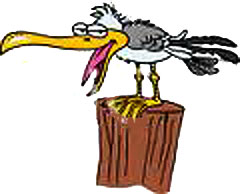 provided more than
ample feeding grounds for such familiar species as the herring
gull. This has led to a great increase in their numbers.
provided more than
ample feeding grounds for such familiar species as the herring
gull. This has led to a great increase in their numbers.
To many people all the birds seen near the sea are "seagulls."
Actually there are many different kind of birds who make their
living from the sea. There are shags, eagles, sea doves, and a
host of others.
This, however, is a true seagull, a Herring Gull (Larus argentatus),
one of the most familiar seaside birds on both Greek coasts and
inland areas. For the so-called seagull is just as apt to follow
a tractor and pick up grasshoppers on a farm as it is to pick
up clams and crabs from a beach.
Gulls are not good fishermen, but they are excellent scavengers and will eat nearly anything. They are important in cleaning up harbors and beaches. They are know to pick up shellfish and drop them from the air into a rock, road, house or car to crack them open. Although they can swim passably well, they cannot dive or swim under water.
Herring gulls are the most familiar and widespread of the gull species. A big, bold bird frequently seen following boats, herring gulls are sociable birds who hunt, migrate and feed together. They are long lived as birds go -one record of a banded chick was recovered 28 years later. They build nests on the ground and raise two or three young at a time.
The Herring Gull is everybody's idea of a seagull, being present throughout the year at coastal cliffs, beaches, harbors and towns. It is also familiar at inland sites in winter, especially reservoirs and refuse tips. Its pale gray back separates it from the Black-backed Gulls and its larger size, more menacing profile and red-spotted beak distinguish it from the Common Gull.
First winter birds are harder to separate from the similar-sized Lesser Black-backs though they are slightly bulkier and the feathers of the wing and mantle show more extensive pale markings, making their upper parts look blotchy rather than mostly dark. In flight the inner primaries are noticeably paler than the rest, making a diagnostic pale panel.
The Herring Gull breeds on coastal cliffs, sand dunes and buildings. Winters on
estuaries, lakes, reservoirs, coasts and rubbish tips.
|
 Herring Gull: Breeds from Alaska east across northern Canada to Maritime Provinces, south to British Columbia, north-central Canada, and Great Lakes, and along Atlantic coast to North Carolina. Winters in all but its northernmost breeding areas and from southern Alaska to Baja California. Nests on open beaches, islands, or shorelines; stays on lakes, wetlands, rivers, and landfills. Hear the gulls Herring Gull: Breeds from Alaska east across northern Canada to Maritime Provinces, south to British Columbia, north-central Canada, and Great Lakes, and along Atlantic coast to North Carolina. Winters in all but its northernmost breeding areas and from southern Alaska to Baja California. Nests on open beaches, islands, or shorelines; stays on lakes, wetlands, rivers, and landfills. Hear the gulls |
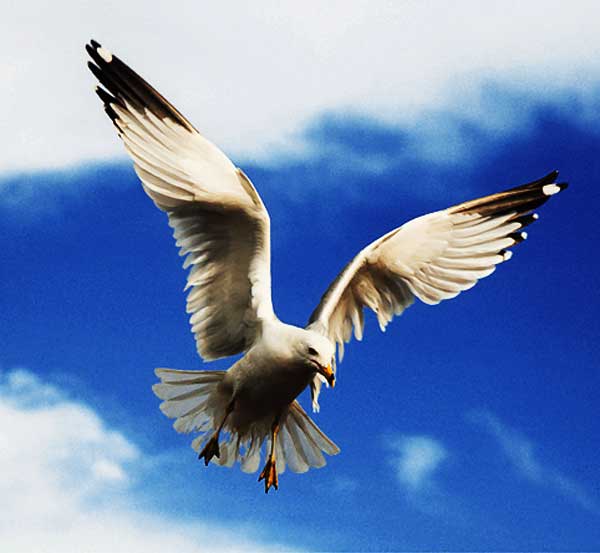 |
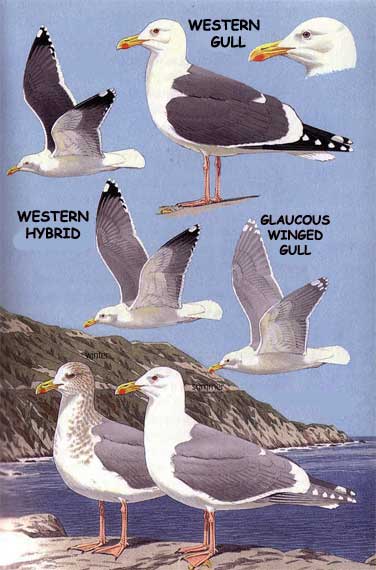 |
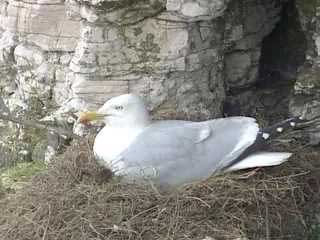 Herring Gull nesting high in the cliffs |
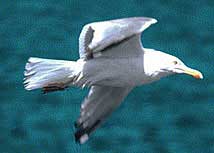 An extremely common resident gull, the most familiar is Black-headed. Particularly numerous around the coast but, also found inland in large numbers. |
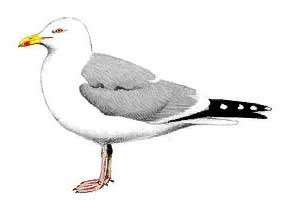 Side view profile of the Herring Gull |
Specifications Length: 24 in Wingspan: 56 in Weight: 2 to 3 lbs Engine: Bio Fuel: most anything Service Ceiling: 3000 ft Range: 65 mi or more |
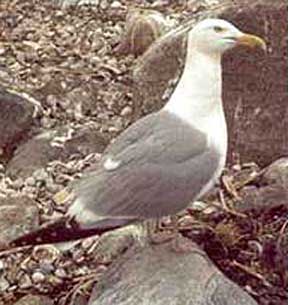 Herring Gull rookery |
  Assorted Herring Gull images |
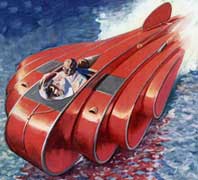 Be sure to visit the Sea Gull Flying Boat page. Check out the FG model then read about how it all was probably a hoax pulled off by Popular Science magazine desperate for sales back in 1933 !! |
 Herring Gull 'Happy to see you' |
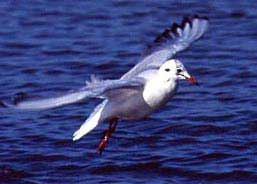 Herring Gull banking to land. Note how its wing upper surface feathers are flapping upward to prevent low speed stall. Incredible !! |
|
Some other things of interest
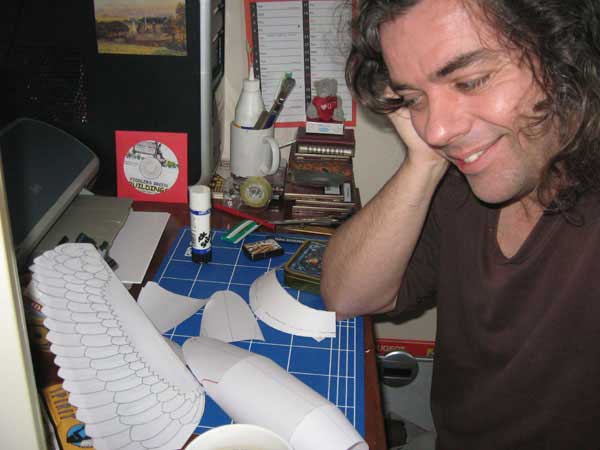 Derek Roberts, the designer, in his spacious card model studio, Norfolk, UK. Note the models isn't quite like the earlier version on which he was working. |
 A group of gulls has many collective nouns, including a "flotilla", "gullery", "screech", "scavenging, and "squabble" of gulls. Communication between these birds is complex and highly-developed, employing both calls and body language. Two identical vocalizations can have very different meanings, depending on the positionings of the head, body, wings and tail relative to each other. Herring Gull flocks have a loose pecking order, based on size, aggressiveness, and physical strength. Jonathan Seagull discovered that boredom and fear and anger are the reasons that gull’s life is so short and with these gone from his thought, he lived a long fine life indeed. |
 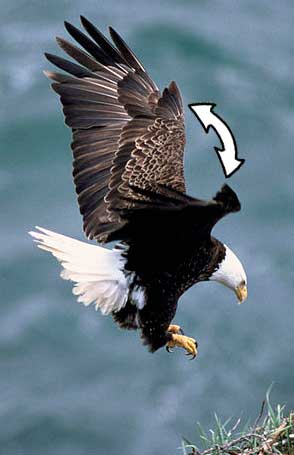 These two photos show some of the magic birds wings produce.. Most interesting is the alula. While easy to overlook, the alula is essential to a modern bird’s aerodynamics. A bird approaching the ground needs to slow down in order not to crash, and it does that by rotating its wings to a steeper angle. This maneuver has a potential pitfall: since air can no longer glide smoothly over the top of the wing, it breaks up into turbulent eddies. The imbalance of low-pressure turbulent air behind the bird’s wings and smooth-flowing high-pressure air in front creates more drag than the bird wants, and it stalls and drops to the ground--unless it happens to have some anatomic turbulence-buster. That’s the alula. When pressure drops on top of the wing, the bird automatically lifts the alula, which means it is lifting its first digit. This creates a slot between the main wing and the alula. Air slips through the slot and glides smoothly over the top of the wing, and the bird slows without stalling. (see below). Next time you eat a chicken wing notice there's a prehistoric (but chewy) alula right there on the top. Yum |
 Just as in an airplane, lift is increased as the wing is tilted upward into the airstream and as long as air flows smoothly, the wing flies 'A'. But if it is tilted up too much, turbulence sets in above the wing and lift is destroyed 'B'. But, on the leading edge of most bird's wings the alula pops up to smooth out the turbulent airflow so lift is maintained. The alula is under muscular control always ready when needed. |
 |
| The down stroke is the power stroke, and it's effective because the primary feather hold firm overlapping each other to present a 'closed' surface to the air..(left). On the upstroke, however, they open to allow air to slip through making it easier to lift the wing |
|
 |
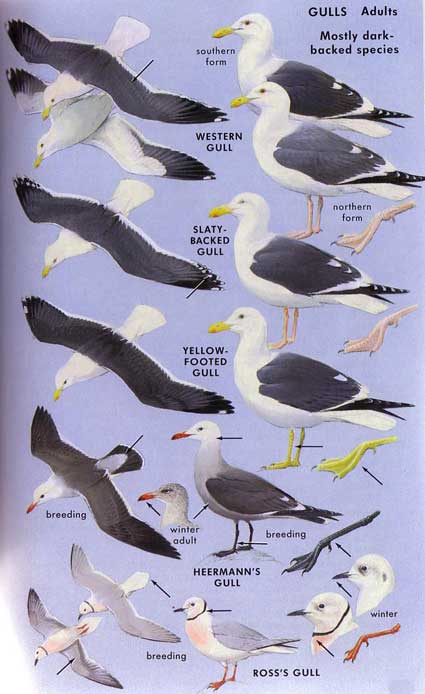 |
 Fiddlers Green has become known for its fantastic instruction sheets- each one could be easily enlarged to poster size and appreciated by all. |
This is the advert that announced the Herring Gull model-July 2011 |
|
"Argue for your limitations and sure enough, they’re yours."
Richard Bach in Jonathan Livingston Seagull.
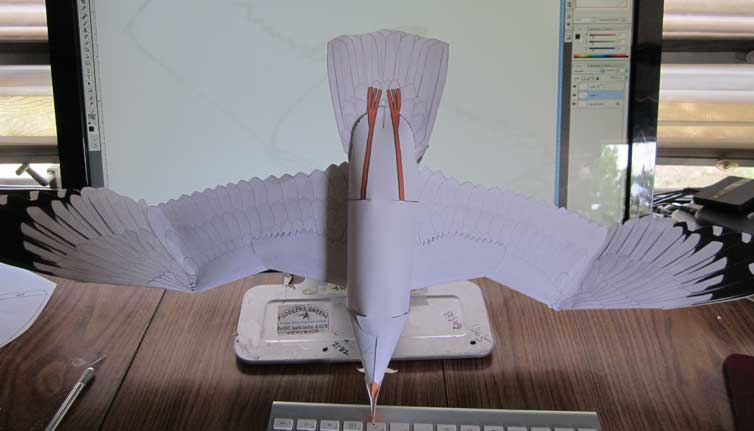 This view looking up should help to grasp the general idea. The entire kit has only 10 pieces (plus a few optional or alternate pieces). Use the optional body that has a very light legs outlined IF you plan to add the built up legs.. |
|
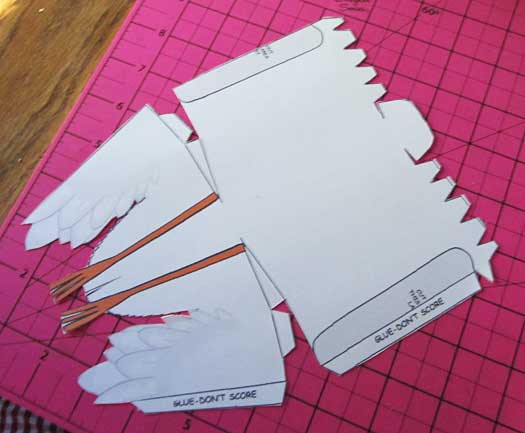 The fuselage is basically one piece. Can't be easier |
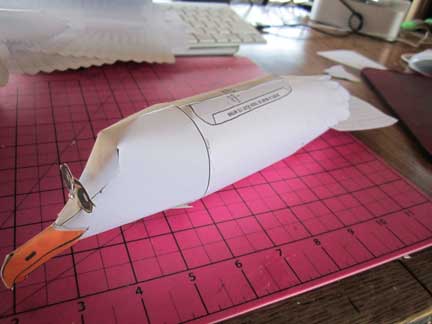 Fuselage finished with tail included- 3 pieces !! |
 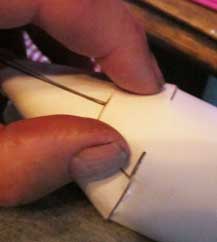 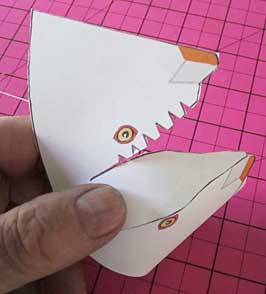 Special effort needs to be taken to glue Mr Gull's head onto the 10 tabs leaving the neck area to hang unattached awaiting the breast (shown in the middle photo). Try and cut all lines just inside the black to produce a whiter gull. |
|
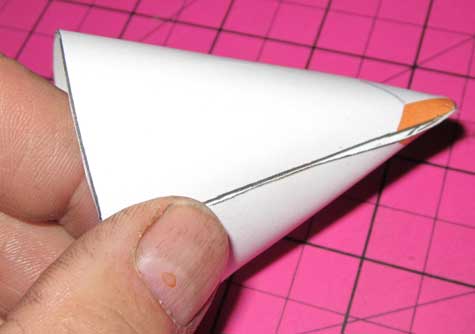 The gull's head is curved and glued along the bottom. Glue the head to the tabs on the front end of the fuselage. |
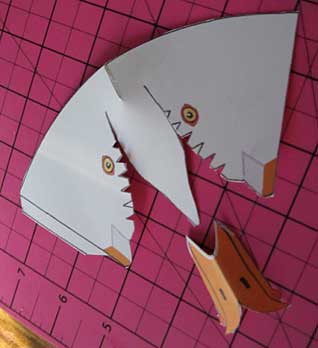 Looks like some sort of a stepped on sea monster |
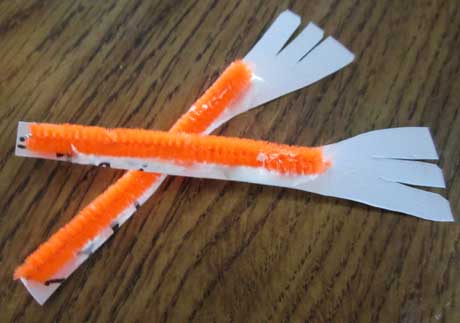 Legs are rounded and glued around pipe cleaners |
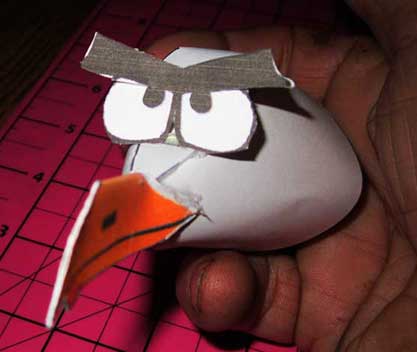 This is a shot of the 'goofy' version head. The other head is more realistic and they're interchangeable |
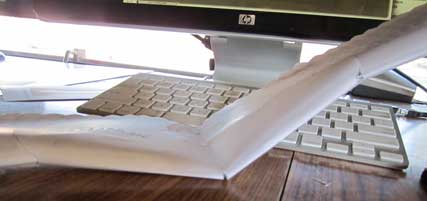 The wings can be easily 'folded' upward especially if you've taken the effort to imbed a piece of wire coat hanger in the leading edge. |
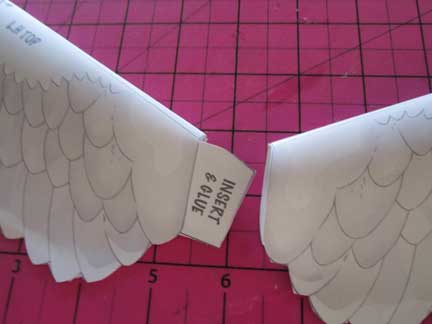 Wings coming together..stand back !! |
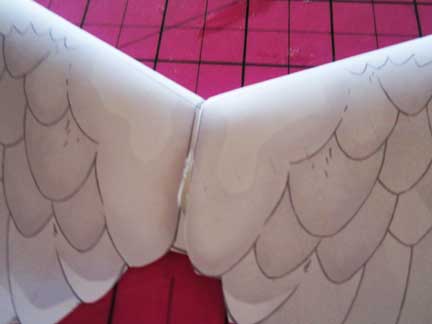 The wings glue together nicely but become rigid when the center section is added. |
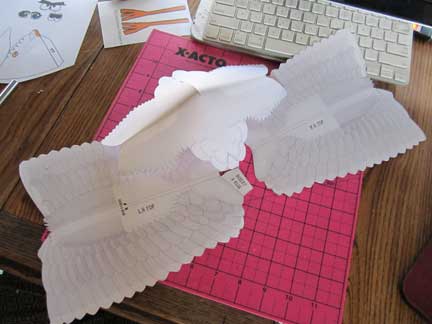 The entire wing is in just 5 sections giving a very rigid span of about 31 inches |
Getting your Herring Gull to glide
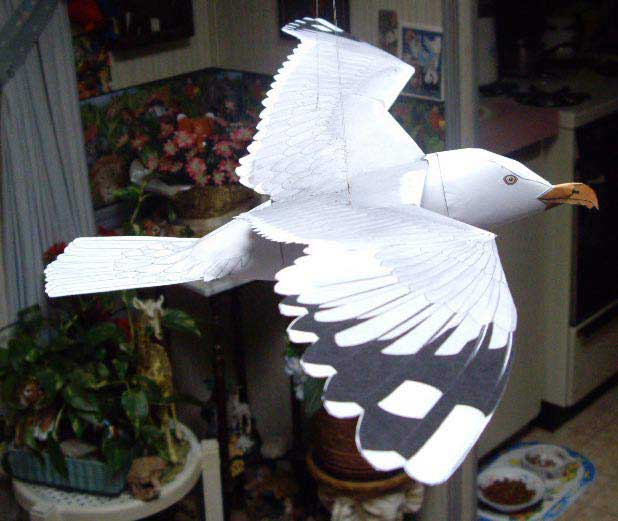 |
High aspect ratio wings abound in nature. Most birds that fly long distances have wings of high aspect ratio, and with tapered or elliptical wingtips. This is particularly noticeable on soaring birds such as gulls and especially albatrosses. By contrast, hawks and pheasants have wings of low aspect ratio (and long tails) With an aspect ratio of almost 8, your herring gull can become a great little glider..A two inch common nail buried in the beak seems about right for ballast.(also protects the beak when HG flies into a wall) Be sure your gull's wings are reinforced with a light but stiff wire so they hold their shape . Be ready to carefully tweak the wings and tail. As shown on the instruction sheet, attach an opened paper clip at the joint just aft of the brest with lots of hot melt glue. A large rubber band launches him nicely. |
The Bob Martin's Herring Sea Gull Collection
 Meet Bob and family. Bob is retired, basically but when he's not cardmodeling he's probably out installing a satellite dish system. |
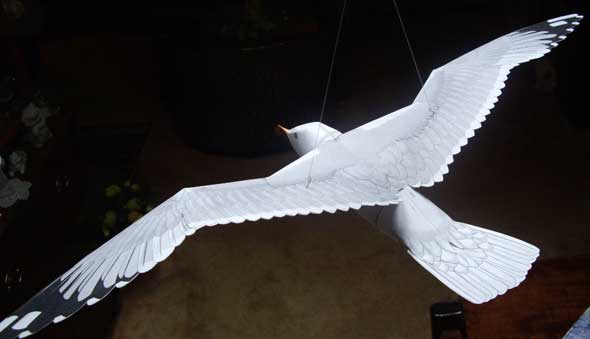 Display your gull, ideally, from two thin wires attached mid-wings to preclude eventual drooping. |
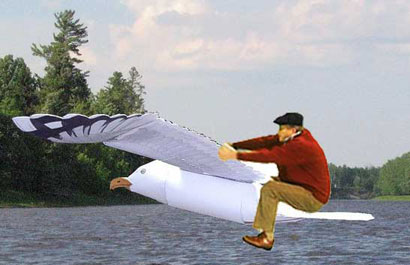 The launch was great and Bob quickly learned to steer the gull by grabbing a wing, but (we won't go into why :), the gull just couldn't gain altitude. Tall trees ahead. whooa The launch was great and Bob quickly learned to steer the gull by grabbing a wing, but (we won't go into why :), the gull just couldn't gain altitude. Tall trees ahead. whooa |
 This little poser got caught on Bob's lamp |
 "A moment later Jonathan’s body wavered in the air, shimmering, and began to go transparent. “Don’t let them spread silly rumors about me, or make me a god. O. K., Fletch? I’m a seagull. I like to fly, maybe…” (from Jonathan Seagull) |
Summary
Herring Gull
The American Herring Gull (Larus smithsonianus), a large, adaptable seabird, is the most familiar gull along North Atlantic coasts, with adults featuring light-gray backs, white underparts, black wingtips, yellow eyes, and pink legs, measuring 22-26 inches in length, 49-61 inches wingspan, and weighing 1.3-3.6 pounds. Omnivorous opportunists, they forage on fish, invertebrates, eggs, garbage, and carrion, using dives, drops, and theft; habitat includes coasts, lakes, rivers, dumps, and fields, breeding colonially on islands with ground nests of three eggs incubated 27-30 days. Reaching maturity at 4-5 years, they exhibit varied immature plumages over four years; populations recovered from 19th-century declines but face modern threats like botulism and reduced fisheries. Known for sibling rivalry in clutches and heat-shedding behaviors, these long-lived birds (up to 29 years) symbolize coastal ecosystems across North America.
Jonathan Livingston Seagull Video
This video is an audiobook reading of Jonathan Livingston Seagull, narrated by Richard Harris. (runtime 45 minutes)



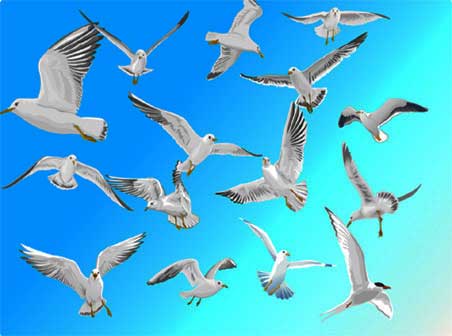
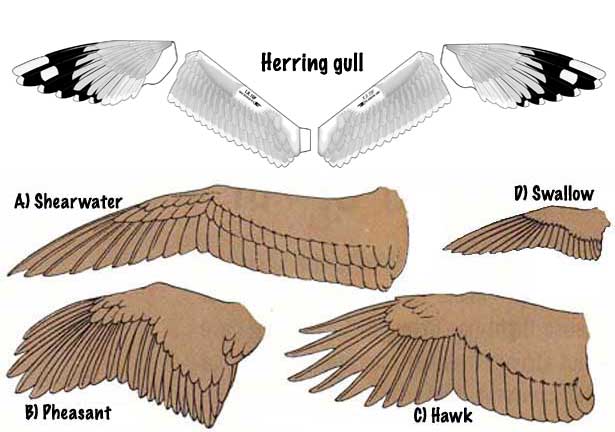 Wing shapes reflect uses.
Wing shapes reflect uses.